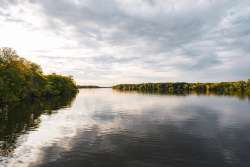North America is home to three distinct subspecies of the Least Tern shorebird. All three are nearly identical to the human eye, and all are equally small, spunky and determined to survive. If you’ve walked along a sandy Gulf beach shoreline in the summer, you may have been dive-bombed and called at by this courageous but small bird. Although they weigh in at only around 1.5 ounces, these terns will do their best to keep people away from their inconspicuous nests of even tinier chicks in the sand.
The Interior Least Tern prefers to breed inland along river systems rather than along the oceanic coast. In Louisiana specifically, the Interior Least Tern breeds along the Mississippi River, where the birds nest in colonies along unvegetated sandbars and lay their eggs in shallow depressions on the ground. If you cruise along the river in the summertime, you might see Least Terns gliding along the river in search of fish to eat.
Just a few decades ago, Interior Least Tern numbers in the U.S. were dire, with less than 2,000 total remaining. Human-engineered alterations to the river for navigation and irrigation (in the form of dams, dikes, reservoirs and the like) had completely altered the tern’s breeding habitat. Where sandbars used to peak out among wide, undisturbed river channels, a narrower river flooded breeding colonies. Additionally, harvest for feathers and other human disturbances were driving the species toward extinction.
In 1985, the Interior Least Tern was protected when it was declared endangered by the U.S. Fish & Wildlife Service. Efforts to better manage and restore river habitat were put underway: dredged materials created new nesting sites, protective measures were implemented to reduce human disturbance to birds, and river management turned to focus on restoring the river’s pathway to more closely mimic a natural flow. In a proud conservation win, the Interior Least Tern was removed from the Endangered Species list in early 2021. Today, the species is still federally protected under the Migratory Bird Treaty Act (MBTA).
Mississippi River Restoration
The National Wildlife Federation is a proud member of the Restore the Mississippi River Delta Coalition. Through this coalition, we promote scientifically sound, sustainable, large-scale projects that restore the natural flow of the Mississippi River and enhance habitat for wildlife. The Mississippi River has been heavily modified and altered by humans over the years as they attempted to idealize the flow for navigation, irrigation and drinking water. This caused the Mississippi River Delta to collapse.
Since the 1930s, Louisiana has lost about 2,000 square miles of land that have disappeared into open water. Combine this with climate-related sea level rise and intensifying storms, and Louisiana is facing a land loss crisis. Give Least Terns space! If you see Least Terns along the river or the beach, give them a wide berth. These birds are extremely vulnerable to human disturbance. If humans and/or pets approach too closely, they will fly up into the air, exposing their eggs and flightless chicks to predators and heat that can be lethal. Even if you are simply cruising by on a boat, make sure you leave plenty of space between you and the birds.
Volunteer to help protect shorebirds! You can work with our partner organization, Audubon Louisiana, and volunteer to protect nesting Least Terns and other shorebirds. Spend your time on the shore watching out for adorable baby birds – what could be better?!
Get involved with the Mississippi River Delta Coalition! You can make a difference in habitat restoration by volunteering, attending upcoming events, donating, or even just keeping yourself updated and spreading the word.
NWF also works with local and state partners in areas all along the Mississippi River and its watershed to better manage the river system holistically. Through many dynamic projects to restore marshes, create ridges, and divert sediment, we are working to rebuild land along Louisiana’s coasts and rivers – land that will provide breeding and resting habitat for magnificent critters like the Least Tern.





